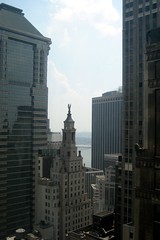
Image by Lee Gillen via Flickr
When New Yorkers talk to me about improving the quality-of-life in our city, one topic that always comes up is parking tickets. Let’s face it, that little orange rectangle on your windshield can put a major crimp in your day – and a major dent in your wallet.
A bustling city like ours needs traffic laws to keep the streets safe, and to keep the businesses on our commercial corridors thriving. Many of those businesses depend on the turnover of metered spots to keep the customers coming throughout the day.
While we can’t stop issuing tickets when people break the law, we can reduce the headaches that come with paying and disputing them. And last week, we launched an enhanced online hearing program that will do that by allowing New Yorkers to contest certain types of tickets without ever leaving the comforts of their homes or offices.
We’ve long offered a web payment option for parking tickets on the city’s website, nyc.gov. But now, Web users will have the ability to complete the entire hearing and payment process online. You can request a web hearing and upload your evidence in a matter of minutes, and then receive a ruling by e-mail in just a few weeks, instead of a few months.
Online hearings are now also available for tickets involving other health and safety matters, including off-leash dogs, dirty or obstructed sidewalks, and improper recycling. The city’s Environmental Control Board, which has jurisdiction over these types of violations, has added a one-click hearing function to their webpage, also available on nyc.gov. That means residents and small business owners who wants to dispute these kinds of tickets will no longer have to take time out of the workday to appear before a judge. Instead, they can contest the tickets online whenever it’s convenient for them – whether that’s noon on a Sunday, or midnight on a Thursday.
By offering a completely paperless way to dispute and process parking and other violations, we are helping our customers save time and money. And we are helping city employees to work more efficiently. For example, we’ll now require fewer clerical personnel to process paperwork. We’ll also increase the productivity of our administrative law judges, who will be able to make use of the down time between live hearings to review digital cases.
Expanding and improving online hearings is just one of a series of steps we intend to take to make the city’s tribunals more user-friendly. And it’s also just the latest example of how we’re using technology to improve the delivery of services. Just like the QR – or Quick Response – codes we’re adding to all of our building permits, and the new “Leak Notification” program we rolled out earlier this month, these web hearings will make it easier for you to access critical information and services on your terms – and on your schedule.






